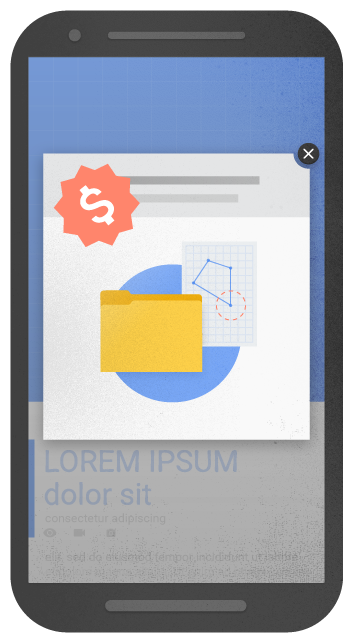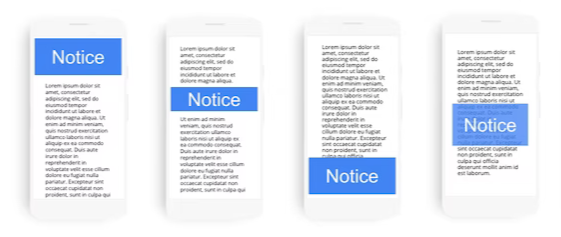煩わしいインタースティシャルやダイアログを避ける

煩わしいインタースティシャルやダイアログとは、主にプロモーション目的で、ユーザーのコンテンツ閲覧を妨害するページ要素のことです。インタースティシャルはページ全体を覆うオーバーレイ、ダイアログはページの一部のみを覆うオーバーレイであり、場合によっては元のコンテンツが見えにくくなります。
さまざまな理由により、ウェブサイトにダイアログの表示が必要になることがよくありますが、煩わしいインタースティシャルでユーザーの閲覧を妨害すると、ユーザーの不満を招き、ウェブサイトへの信頼を損ないかねません。
煩わしいダイアログやインタースティシャルが表示されると、Google や他の検索エンジンがコンテンツを把握することが困難になり、検索のパフォーマンスが低下する可能性があります。同様に、ユーザーがサイトを使いにくいと感じれば、検索エンジン経由も含め、そのサイトに再度アクセスする可能性は低くなります。
煩わしくないダイアログを作成する
煩わしくないダイアログを作成すれば、ユーザーはダイアログによって妨害されることなくコンテンツにアクセスできます。これは、アプリ インストール用のプロンプトを含む、あらゆる種類のプロモーション用ダイアログに当てはまります。次のベスト プラクティスを取り入れることで、ユーザーが快適にサイトを利用できるだけでなく、Google 検索がサイトのコンテンツと構造を把握しやすくなります。
インタースティシャルではなくバナーを使用する

ユーザーの注意を引くには、ページ全体を覆うインタースティシャルではなく、画面のほんの一部だけを覆うバナーを使用しましょう。バナーを使用することで、ユーザーと検索エンジンは、ページに到達すると同時にコンテンツにアクセスできるようになります。
こうしたバナーはさまざまな方法で実装できます。たとえば、アプリ インストールのバナーには、ブラウザでサポートされるバナー(Safari の場合はスマート アプリバナー、Chrome の場合はアプリ内インストール)を使用できます。また、一般的な小型広告に似た HTML バナーを作成し、アプリストアの適切なダウンロード ページへのリンクを設定する方法もあります。この小さなコンテナは、ニュースレター購読申し込み用のプロンプトなど、他の種類の通知にも利用できます。
共通ライブラリを使用する
多くの CMS には、ニュースレター購読申し込み用のプロンプトなど、一般的なユースケースに対応した標準的なダイアログやインタースティシャルを作成するプラグインが用意されています。たとえば WordPress を利用している場合は、「newsletter signup wordpress」と検索します。こうしたプラグインの使用は、Google や他の検索エンジン、インターネット全般にとって有益です。なぜなら、プラグインのデベロッパーが大規模な改善を実施できるためです。
よくあるミスを回避する
法律で義務付けられている場合を除き、ダイアログやインタースティシャルを設計する際には、Google 検索がコンテンツをクロールし把握しやすくするために、以下に示すよくあるミスを避けるようにしてください。
- インタースティシャルでページ全体を覆わないようにする。
- 同意や入力のために、ユーザーを別のページにリダイレクトしないようにする。
必須のインタースティシャル
一部のサイトでは、公開するコンテンツの種類によって、インタースティシャルの表示が必須とされます。たとえばカジノのサイトでは、ユーザーがコンテンツにアクセスする前に年齢を入力する年齢確認のインタースティシャルを表示することが必要になる場合があります。
必須のインタースティシャルは、このドキュメントで説明しているガイドラインの適用対象外です。ただし、可能であれば、以下のベスト プラクティスを採用することをおすすめします。
- コンテンツがインタースティシャルによって覆われていることを確認する。これにより、Google が少なくとも一部のコンテンツをインデックスに登録し、検索結果に表示できる可能性があります。
- 同意の取得やデータの提供のために、受信した HTTP リクエストを別のページにリダイレクトしないようにする。すべての URL を 1 つのページにリダイレクトすると、Googlebot はそのページしか取得できないため、そのページを除く他のページがすべて検索結果から削除されます。
成人ユーザー向けに年齢確認が必須となっているコンテンツについては、年齢確認をトリガーすることなく Googlebot がコンテンツをクロールできるようにすることをおすすめします。これは、Googlebot のリクエストを確認し、年齢確認なしでコンテンツを提供することで可能です。
